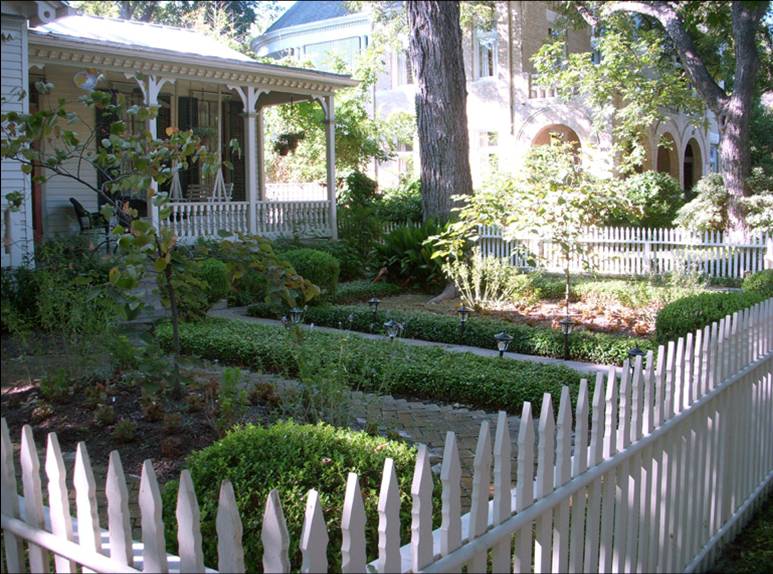Deciphering the Guidelines: Front Yards

Written by: Cory Edwards, Office of Historic Preservation Staff
Front Yard Landscaping and Site Elements
Each of San Antonio’s residential historic districts is a unique placeholder in time. Residents and tourists alike are able to enjoy these districts and gain understanding of what domestic life in San Antonio was once like. For most people, historic properties are viewed from the public domain, making those spaces which are immediately visible from streets and pedestrian walkways an important aspect in historic district preservation. Because of this, an emphasis is placed on front yard appearance in the historic and design review process.
Many residents in historic districts may be surprised to learn that the Office of Historic Preservation (OHP) requires a Certificate of Appropriateness for all landscaping and site improvements. While this is not a new regulation, only recently has OHP been able to provide clear and comprehensible guidelines to property owners regarding their front yards. In November 2012, City Council adopted the Historic Design Guidelines which are applicable to all properties that are zoned as historic. The Guidelines address a multitude of preservation-related issues. However, the chapter pertaining to site elements (aka landscaping) has perhaps gained the most public interest. By better understanding the intent of the guidelines as they pertain to front yards, historic homeowners now have a useful tool for improving the overall quality and character of their streetscapes.
Front yards can contribute to the quality and character of historic districts. Photo by Mike Pecan.
Respect the Context
San Antonio’s residential districts represent a broad range of historical developments. Front yards to the 19th-Century homes in the King William and Lavaca historic districts inherently possess a different vernacular than the more suburban developments like Olmos Park Terrace and Monticello Park. Front yard landscaping schemes should respond to established historic patterns found within the district, and in some instances, this pattern may vary street to street. On a street which features small, front yard gardens, avoid interrupting the continuity along the street with an open lawn, wide driveway or large gravel beds. The opposite may also apply depending on the context. On a street with predominately open lawns, avoid enclosing a front yard with fences and walls or planting dense or tall species along the sidewalk. Maintaining a consistent street edge in historic districts improves how the historic character of the district can be interpreted by eliminating visual distractions and non-historic installations.
Generally avoid the addition of inappropriate materials along the pedestrian sidewalk and parkway space such as inorganic mulch, unnatural rockscapes or impervious paving.
Maintaining the character of historic front yards creates cohesive and distinctive neighborhoods.
Maintain the Character
Any new site elements introduced to the front yard should be appropriate and consistent with the style and character of the house and/or the historic district. For instance, front yard fences, where appropriate within the context of the district, should be designed based on either historic precedent or should reference the architectural style and materials of the house. Similarly, new paving such as walkways and driveways should correspond to historic precedents found in the neighborhood. For instance, avoid installing large concrete driveways in a district where modest gravel or ribbon driveways are more common. Materials in general should respond to the unique character of the property. Don’t be sold on modern, mass-produced products such as interlocking pavers and faux stone blocks which are not recommended.
This type of wood fence has historic precedence in the King William Historic District. Photo courtesy of UTSA Digital Archives.
Plant Smarter
San Antonio has a warm, temperate climate that supports a diverse palate of plant species and allows for almost year-round green. In small front yards or side yards, a densely-planted garden could potentially provide interest throughout all four seasons. In larger yards that have traditionally featured open lawn areas with turf grass, homeowners may find it difficult or impractical to maintain an attractive lawn year-round. In many instances, low-growing or spreading native species are a suitable replacement for turf grass and are more resistant to seasonal extremes.
Front yards can be kept low-maintenance by incorporating low-growing and spreading species versus traditional turf grass.
As infrastructure demands of an ever-growing city continue to strain our finite water sources, water conservation is at the forefront of today’s landscaping conversation. The implementation of xeric and low-maintenance landscapes is nothing new to San Antonio. Native species were incorporated in front yard landscaping schemes long before the introduction of modern-day irrigation. The City of San Antonio maintains an appendix of native plants which all thrive in our local climate. The appendix is available here.




